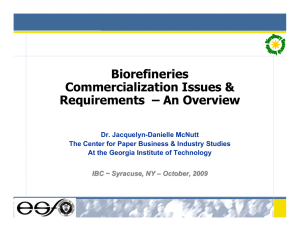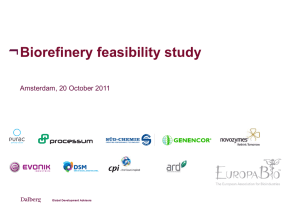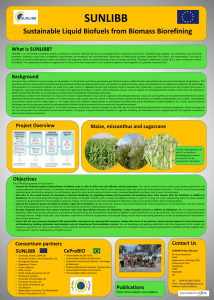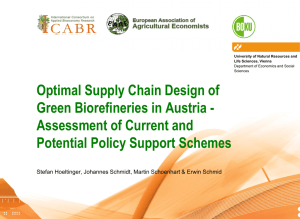Reach-Futurology_biorefining - Rob Bevan
advertisement
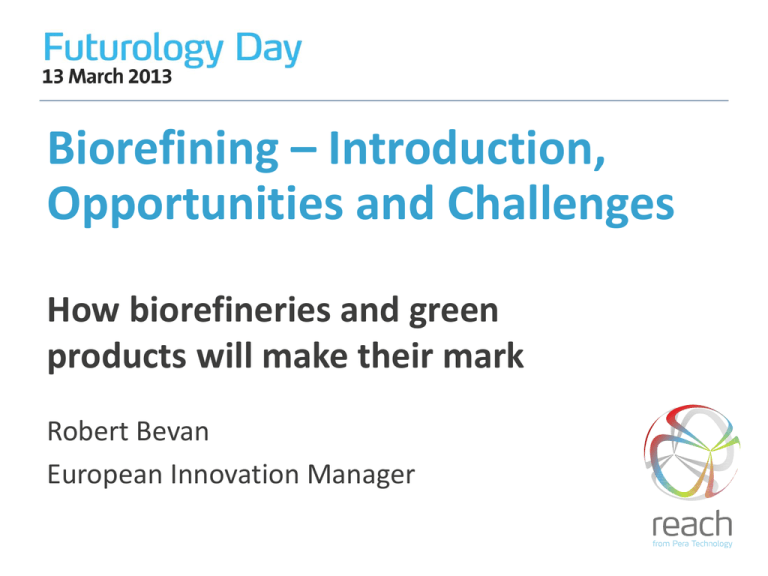
Biorefining – Introduction, Opportunities and Challenges How biorefineries and green products will make their mark Robert Bevan European Innovation Manager What are Biorefineries? • Biorefineries are facilities that convert biomass feedstocks to bio-based energy, fuels, materials and chemicals Biomass Feedstock Sugar/Starch Crops: e.g. sugar cane / corn Oil Crops: e.g. rapeseed, soybean Lignocellulosic Biomass: e.g. forestry & agricultural wastes Industrial wastes: brewers spent grain, potato pealing's etc… Conversion Technologies Thermal processes: e.g. pyrolysis, gasification Chemical processes: e.g. classical catalysis Biotransformation: e.g. fermentation, enzymatic catalysis Product Stream Energy: e.g. heat, electricity Fuels: e.g. biodiesel, bioethanol, biogas Chemicals: e.g. bulk, intermediate, final Materials: e.g. polymers Gasification / Pyrolysis Classical Chemistry Oils / Syn-Gas Existing Products Brewers Spent Grain Chemo- / Bio-Tech Sugars Fermentation Bio-Based Products Why are biorefineries important? • Growing demand for energy, fuel, materials and chemicals (growing market) • Finite availability of fossil fuel resources (continued price rises) • Overdependence of many countries on imported resources (national security) • Reality of climate change and need to reduce greenhouse gases (societal demand for eco-production) • Competitiveness within the global economy • Need to stimulate growth within rural economies First Generation Biorefineries • Target production of a single product stream from the biomass feedstock • A number of first generation biorefineries exist today: • Rapeseed oil to biodiesel • Sugar cane to bioethanol • Corn starch to polylactic acid • Gasification of biomass to syngas followed by chemo- / biotransformation to bioethanol (INEOS) Limitations of First Generation Biorefineries • Generate high volumes of by-products that have limited commercial value (e.g. animal feed, energy recovery) • Poor competitiveness compared to optimised petrochemical equivalents that derived multiple product streams and utilise ~100% of feedstocks • Require feedstock crops rich in the target sugar / starch / oil fraction, typically in competition with food (cereal, oilseed) First generation biorefineries are largely being driven through legislative targets and favourable taxation for biofuels Second Generation Biorefineries • Multiple product streams from sustainable biomass feedstocks – similar to petroleum refineries • Lignocellulose based biorefineries HEMICELLULOSE CELLULOSE LIGNOCELLULOSE LIGNIN LIGNOCELLULOSE BIOMASS CELLULOSE HEMICELLULOSE C6 SUGARS • • C5 SUGARS • Fuels Platform & Intermediate Chemicals Polymers OLIGOMERS • • Functional food & feeds Medicinal / pharma LIGNIN MONOMERS • Aromatic platform chemicals (BTX / vanillin) LIGNIN MACROMOLECULES • • Bio-resins Functional additives BULK EXTRACTIVES • • Organic / fatty acids Resins FINE EXTRACTIVES • • Essential oils Phytosterols LIGNIN DIRECT EXTRACTABLES Advantages of Second Generation Biorefineries • Complete valorisation of feedstocks, thereby: • enabling optimal use of available resources • generating highest value return • Integration of multiple processes leading to competitiveness in line with petrochemical refineries • Enable use of more sustainable feedstocks (agricultural, forestry & industrial wastes) • Viability at small to medium scale: • Flexible configuration (niche markets) • Rural development capitalising on regional diversity Hemicellulsoe to functional food ingredients Lignin to adhesives & additives Brewers Spent Grain Cellulose to biopolymer Key limitations / Research Challenges (1) • Cost effective pre-treatment processes enabling recovery of all three lignocellulose fractions in a form suitable for subsequent downstream processing • Methodologies for the valorisation of hemicellulose: • Hemicellulases for controlled hydrolysis to building block sugars • Engineering of microorganisms enabling fermentation of C5 sugars • Methodologies for the controlled and selective depolymerisation and transformation of lignin to macromolecular and aromatic platform chemical product streams Key limitations / Research Challenges (2) • Demonstration of potential for scale-up and integration of new and emerging technologies within existing and future biorefineries • End-user knowledge for use of the resulting bio-based chemicals and materials Petrochemical: • Simple-reduced platform chemicals • Established processes for building up complexity • Strong end-user knowledge base for use Bio-Based: vs • Complex multifunction oxidised platform chemicals • Emerging non-optimised transformation processes • Limited end-user knowledge base for use Potential Global Market By 2020 Case Study 1 - MicroGrass • Microwave plasma pre-treatment process for the rapid breakdown of lignocellulose to sugars for fermentation of ethanol • Objectives: • Increased sugar yield = >90% (SOA = <40%) • Quicker Process = <0.5 days (SOA = ~2 days) • Reduced energy = <90% of existing processes • Result = prototype demonstrator Case Study 2 - BioSonic • Ultrasonically assisted organosolv pretreatment of lignocellulose biomass targeting recovery of minimally degraded cellulose, hemicellulose and lignin fractions • Objectives: • Efficient recovery of all three fractions with minimal degradation • Quicker process times • Reduced energy consumption & cost • Environmentally friendly / non-toxic solvents • Result = prototype demonstrator Case Study 3 - AquaCell • A novel microbial fuel cell process for conversion of industrial organic wastewaters to value product streams (electricity & hydrogen) • Objectives: • Extract value from wastewater • Reduce energy and sludge disposal costs • Eliminate micro-pollutants and enable water re-use (non-potable) • Result = prototype demonstrator Vision of the Future • Companies will adopt biorefineries to valorise their waste, either directly or via centralised facilities • Second and third generation technologies will be key to success • Continued growth within biofuels market, but also those markets where biorefineries are able to make products better and/or cheaper • Biorefineries will help to drive global competitiveness and differentiation Useful Documents for Further Information • The Future of Industrial Biorefineries – World Economic Forum • European Biorefinery Joint Strategic Research Roadmap – www.star-colibri.eu/publications • Bio-based Chemicals: Value Added Products from Biorefineries – IEA Bioenergy – Task 42 Biorefinery
